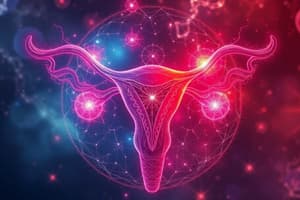Podcast
Questions and Answers
The following are other correct statements about FSH and LH, EXCEPT:
The following are other correct statements about FSH and LH, EXCEPT:
- LH is responsible for the release of the mature egg
- High levels of estrogen further increase FSH (correct)
- FSH is responsible for oogenesis and spermatogenesis
- LH forms the corpus luteum
Estrogen is responsible for the following EXCEPT:
Estrogen is responsible for the following EXCEPT:
- Spinnbarkeit and Ferning, leukorrhea, breast tenderness, vascular spiders, congested nose, palmar erythema, rashes and red blotches on skin
- Goodell’s sign, Hegar’s sign, and Chadwick’s sign
- Osteoporosis (correct)
- Suppression of FSH and prolactin
Which of the following would be your priority intervention for a client experiencing a severe headache and blurring of vision after taking estrogen pills?
Which of the following would be your priority intervention for a client experiencing a severe headache and blurring of vision after taking estrogen pills?
- Inform the woman to proceed to the hospital immediately for further evaluation (correct)
- Advise taking an over-the-counter analgesic or anti-hypertensive drug
- Refer the client to an ophthalmologist
- Allow the client to rest for the day
All of the following are effects of progesterone EXCEPT:
All of the following are effects of progesterone EXCEPT:
Which fact is explained by the inverse relationship between progesterone and oxytocin?
Which fact is explained by the inverse relationship between progesterone and oxytocin?
The following are other correct statements about FSH and LH, EXCEPT:
The following are other correct statements about FSH and LH, EXCEPT:
Estrogen is responsible for the following EXCEPT:
Estrogen is responsible for the following EXCEPT:
Which of the following would be your priority intervention for a client experiencing severe headache and blurring of vision while taking estrogen pills?
Which of the following would be your priority intervention for a client experiencing severe headache and blurring of vision while taking estrogen pills?
All of the following are effects of progesterone EXCEPT:
All of the following are effects of progesterone EXCEPT:
Which of the following facts is explained by the inverse relationship between progesterone and oxytocin?
Which of the following facts is explained by the inverse relationship between progesterone and oxytocin?
Flashcards are hidden until you start studying
Study Notes
Hormonal Roles During Menstrual Cycle and Pregnancy
- Follicle-stimulating hormone (FSH) promotes ovarian follicle development and increases estrogen production.
- Luteinizing hormone (LH) triggers ovulation and aids in corpus luteum formation, releasing mature eggs.
- High estrogen levels exert negative feedback on FSH release from the pituitary gland.
- Ovaries mainly produce estrogen and progesterone when not pregnant; during the first trimester, the corpus luteum takes over this production, transitioning to the placenta after three months.
Effects of Estrogen
- Estrogen leads to various physiological changes: spinnbarkeit, leukorrhea, breast tenderness, and palmar erythema.
- It is linked with Goodell’s sign, Hegar’s sign, and Chadwick’s sign during pregnancy assessments.
- Estrogen is not responsible for osteoporosis; instead, it aids in maintaining bone density.
Immediate Actions for Client Symptoms
- Sudden severe headache and blurred vision in clients on estrogen may indicate stroke or blood clot.
- Immediate hospital evaluation is crucial to rule out life-threatening conditions.
Progesterone Functions During Pregnancy
- Known as the "Hormone of Mothers," progesterone maintains the endometrium, supporting pregnancy.
- Symptoms associated with progesterone include constipation, urinary retention, varicose veins, and heartburn due to smooth muscle relaxation.
- Progesterone does not directly increase vaginal secretions; this is a misconception.
Relationship Between Hormones
- Progesterone inversely relates to oxytocin, influencing uterine contractions and postpartum recovery.
- Estrogen inversely correlates with prolactin, affecting breastfeeding.
- After delivery, decreased progesterone allows for uterine relaxation and stimulates the milk expression reflex supported by oxytocin.
Hormonal Roles During Menstrual Cycle and Pregnancy
- Follicle-stimulating hormone (FSH) promotes ovarian follicle development and increases estrogen production.
- Luteinizing hormone (LH) triggers ovulation and aids in corpus luteum formation, releasing mature eggs.
- High estrogen levels exert negative feedback on FSH release from the pituitary gland.
- Ovaries mainly produce estrogen and progesterone when not pregnant; during the first trimester, the corpus luteum takes over this production, transitioning to the placenta after three months.
Effects of Estrogen
- Estrogen leads to various physiological changes: spinnbarkeit, leukorrhea, breast tenderness, and palmar erythema.
- It is linked with Goodell’s sign, Hegar’s sign, and Chadwick’s sign during pregnancy assessments.
- Estrogen is not responsible for osteoporosis; instead, it aids in maintaining bone density.
Immediate Actions for Client Symptoms
- Sudden severe headache and blurred vision in clients on estrogen may indicate stroke or blood clot.
- Immediate hospital evaluation is crucial to rule out life-threatening conditions.
Progesterone Functions During Pregnancy
- Known as the "Hormone of Mothers," progesterone maintains the endometrium, supporting pregnancy.
- Symptoms associated with progesterone include constipation, urinary retention, varicose veins, and heartburn due to smooth muscle relaxation.
- Progesterone does not directly increase vaginal secretions; this is a misconception.
Relationship Between Hormones
- Progesterone inversely relates to oxytocin, influencing uterine contractions and postpartum recovery.
- Estrogen inversely correlates with prolactin, affecting breastfeeding.
- After delivery, decreased progesterone allows for uterine relaxation and stimulates the milk expression reflex supported by oxytocin.
Studying That Suits You
Use AI to generate personalized quizzes and flashcards to suit your learning preferences.




